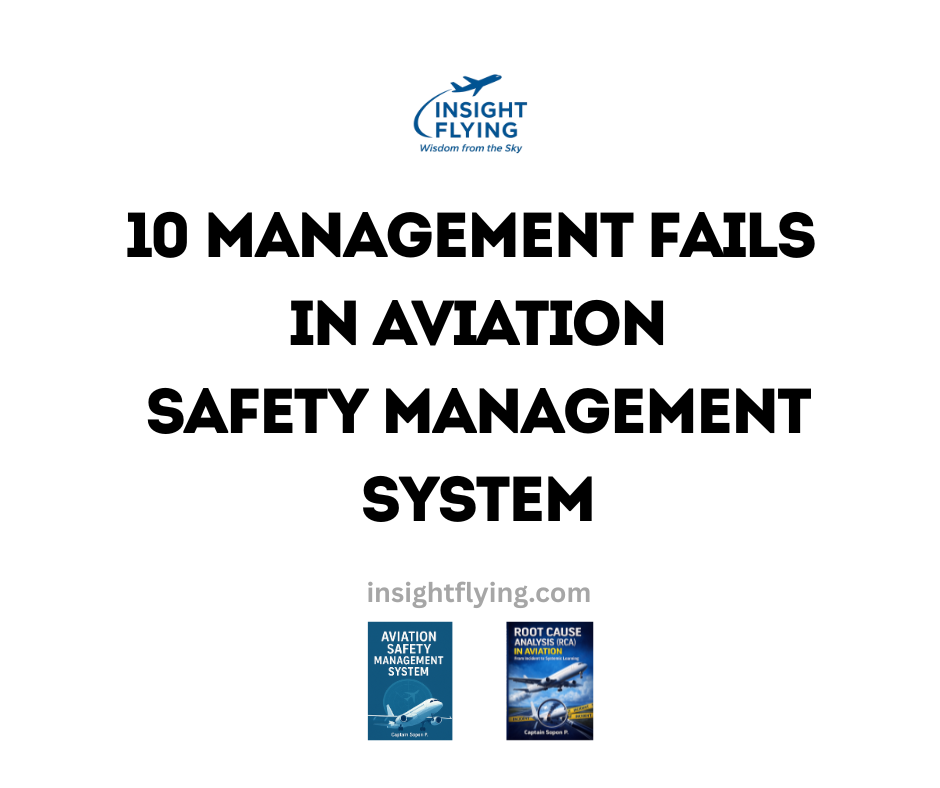InsightFlying.com
by Captain Sopon Phikanesuan
Business email: admin@insightflying.com
Support Us
10 Management Failures in Aviation SMS
Safety Management System (SMS) is not just a regulatory requirement under ICAO Annex 19. It is a management system that must be actively led, enabled, and modelled by the organization’s leadership. Many aviation organizations invest heavily in documentation, training, and compliance audits — yet still struggle to reduce operational risks. The root cause often lies not in frontline operations, but in management behaviours that quietly undermine the SMS.
This chapter explores the 10 most common management failures in global aviation SMS, supported by practical examples from airlines, MROs, ANSPs, and ground service providers. Understanding these failure modes helps leaders identify gaps in their own organizational practices and avoid the pitfalls that weaken safety performance.
1) Treating SMS as “Documentation for Audit” Instead of a True Management System
This is perhaps the most common failure mode. Leadership focuses on producing manuals, completing templates, and preparing evidence for audits — but operational risk remains unaddressed.
Typical Signs
- SMS Manual is complete but not used
- Safety Risk Assessments are done only for compliance
- Annual reviews are conducted to “tick the box”
- Audit readiness dominates the workload of the Safety Office
Example
An airline passes every regulatory audit with minimal findings. However, recurrent runway incursions and unstable approach trends continue for years. SMS documentation is impeccable — but operational risk remains unchanged.
Lesson
Compliance ≠ Safety.
Paper-based SMS cannot prevent operational accidents.
2) Absence of Real Safety Leadership
Management may declare that safety is the top priority, but day-to-day behaviours tell a different story.
Red Flags
- Pressure on OTP outweighs safety margins
- Leaders rarely attend Safety Review Boards
- Managers discourage “too many reports”
- Supervisors downplay issues that reflect poorly on their department
Example
A First Officer reports that a Captain pushed for departure despite crosswind near limits. The manager responds:
“Don’t report small issues. It will make the department look bad.”
This destroys trust and reporting culture.
Lesson
SMS can never be stronger than the leadership that drives it.
3) Insufficient Resources for Safety
Some organizations expect a “world-class SMS” while assigning minimal staff, no data analysts, outdated tools, and inadequate budget.
Common Resource Gaps
- Safety Office staffed by only 1–2 junior personnel
- No Safety Data Analyst despite large flight operations
- Investigations take months because staff are overloaded
- Safety training or promotion has zero budget
Example
An MRO struggles with repeated maintenance errors. Investigations take too long, trend analysis is impossible, and safety promotion is nonexistent due to manpower shortages.
Lesson
No resources = No SMS.
Safety requires people, tools, time, and budget.

|
|
4) Lack of Just Culture — Reporting Discouraged or Punished
Many organizations claim to have a “Just Culture,” but frontline workers know that reporting can lead to blame or disciplinary action.
Example
A maintenance technician reports a possible lapse and requests inspection. Instead of learning from the event, the manager criticizes him for “making the department look careless.”
Technicians stop reporting near misses.
Lesson
A culture of blame will always become a culture of silence.
5) Poor Safety Communication Across the Organization
Information often enters the SMS but never reaches the frontline.
Symptoms
- Reports disappear without feedback
- Lessons learned are not shared
- Corrective actions are not communicated to line stations
- Flight crew and dispatchers receive updates too late or not at all
Example
A series of ATC miscommunication events occur at an aerodrome, but flight crews remain unaware because safety notices were sent only by email — which many do not read.
Lesson
If frontline staff do not know about hazards, those hazards cannot be controlled.
6) Failure to Integrate SMS Into Daily Operations
SMS is treated as a parallel system instead of being embedded into SOPs, workflows, and decision-making.
Example
- Dispatchers are not trained to perform risk assessments on operational changes
- Crew Scheduling does not evaluate fatigue risk when modifying rosters
- Ground crew are unaware of why new procedures exist or what risks they mitigate
Lesson
SMS must be woven into daily operations — not attached as an afterthought.

|
|
7) Reactive Risk Management — Fixing Problems Only After They Occur
Organizations that lack safety intelligence and trend monitoring operate in a reactive mode.
Example
A series of taxiway conflicts occur:
→ A safety reminder is issued
→ Additional training is provided
→ Incidents recur after a few months
No one examines runway layout, charts, ATC workload, or procedural ambiguity.
Lesson
Reactive SMS prevents nothing.
Predictive and proactive methods are essential.
8) Poorly Designed Safety Performance Indicators (SPIs)
Some organizations choose SPIs that are easy to measure but meaningless for operational safety.
Problematic SPI Practices
- Counting the number of reports (quantity over quality)
- Using only lagging indicators
- Setting targets that encourage under-reporting
- No SPIs for human factors, unstable approach, fatigue, CRM, or ATC deviations
Example
An airline boasts “zero high-severity events,” but investigation reveals that frontline staff simply stopped reporting them due to fear of consequences.
Lesson
SPI must reveal reality, not hide it.
9) Line Managers Avoiding Safety Accountability
A major misconception: “Safety is the responsibility of the Safety Office.”
Example
Ground Handling experiences repeat baggage cart runaway events. The department manager says:
“Safety issues belong to the Safety Department, not me.”
The root causes — poor SOP, unclear bay markings, broken chocks — remain unresolved.
Lesson
Risk ownership lies with the Line Manager, not the Safety Office.
10) Superficial Investigations and Failure to Learn
Investigations often focus on human error rather than systemic causes.
Example
A taxiway excursion is blamed solely on “pilot did not follow SOP.”
No one examines:
- SOP complexity
- Fatigue
- Aircraft handling characteristics
- Airport surface conditions
- Pressure due to schedule disruptions
Without systemic analysis, the event repeats.
Lesson
If organizations investigate only to find fault, they never learn — and accidents recur.
Closing Insight
Management failures in SMS are rarely intentional. They arise from:
- Competing priorities
- Misunderstanding of SMS principles
- Insufficient leadership training
- Poor safety culture maturity
- Organizational silos
However, these failures accumulate and undermine the very foundation of operational safety.
Aviation organizations that succeed in SMS are those whose leaders model safety behaviour, empower reporting, resource their safety programs, and integrate safety into every operational decision.
หนังสือการบิน ทางลัดสู่ความเข้าใจที่นำไปใช้งานจริง

|
|

|
|

|
|

|
|

|
|
ขายดีที่สุด

|
|

